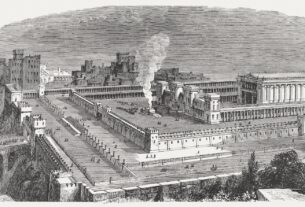Welcome to Tractate Sukkah — the Talmud’s discussion of the rituals and laws relating to the holiday of Sukkot! If you’re new here, we’re so glad you’ve joined us.
Those who’ve been with us on the Daf Yomi journey for a while know that the Talmud’s discussion of the holidays of Yom Kippur and Passover center on sacrificial rituals performed by priests in the Temple in Jerusalem. While Sukkot also features special Temple sacrifices, in this tracate the rabbis’ focus turns to rituals that are less centralized and more domestic in nature: building a sukkah, the temporary outdoor hut for which the holiday is named, and purchasing, owning, and waving a lulav and etrog.
It should not surprise us that both rituals have their basis in the Torah. If you’re new to these rituals or just want a refresher, it might be helpful to read the biblical descriptions before we get started. Leviticus 23:39–43 lays out the laws of the holiday, and Nehemiah 8:13–18 describes how the festival was actually observed by at least some Jews. A careful reader might even notice some key differences between the two accounts!
Today, we dive into the requirements for a sukkah. If you joined us for Tractate Eruvin, you’ll recall the rabbis like to define space carefully, and precisely. Likewise, the mishnah that starts our tractate introduces an extended discussion of the maximum height permitted for one’s sukkah:
A sukkah that is more than 20 cubits (about 30 feet) high is unfit.
Rabbi Yehuda deems it fit.
A sukkah — which imitates the temporary shelters in which Israel dwelt while bringing in the fall harvest and also while wandering through the wilderness on the way to the Promised Land — is supposed to be both like a home, but also profoundly temporary, with a roof made of organic material (s’chach). The rabbis insist that it is the roof that must do the work of casting shade onto the inhabitants of the sukkah — so the sukkah has to be short enough that the s’chach, not just the walls, cast shade inside.
As part of their discussion of this dispute, the rabbis cite the case of one particularly tall sukkah:
Rabbi Yehuda said: There was an incident involving Queen Helene in Lod whose sukkah was more than 20 cubits high, and the elders were entering and exiting and did not say anything to her (about it being unfit).
The rabbis said to him: What does this prove? She was, after all, a woman and therefore exempt from the mitzvah of sukkah.
Rabbi Yehuda said to them in response: Didn’t she have seven sons (and therefore require a fit sukkah)? And furthermore, she performed all of her actions only in accordance with the directives of the sages.
Queen Helene was the dowager queen of Adiabene, a small kingdom in northern Mesopotamia in the first century CE. Together with her sons, she famously converted to Judaism and spent much of her later years in Jerusalem. Both the first century Jewish historian Josephus and the rabbis describe her fabulous wealth and ardent commitment to the Jewish people.
Today’s daf tells us that she spent some of that wealth on a truly epic sukkah. And the rabbis apparently thought that it was kosher!
A sukkah is an outdoor hut, partially open to the elements. It’s supposed to be a private home, but must be open to the community. It has to stand for seven days, but must be temporary. It’s the ultimate liminal space. As such, Queen Helene’s story is the perfect one to open the tractate. After all, she herself is the ultimate liminal character: She’s an outsider (an Adiabene) who becomes an insider (a Jew in Jerusalem). She exemplifies the porous boundaries between Jews and non-Jews, and the commitments that those who enter into the Jewish people can bring to participating in Jewish ritual. She herself creates new ritual spaces that literally push boundaries, and then invites the rabbis in!
As we move through the tractate, we’re going to be debating all kinds of measurements and technicalities — but we’ll keep an eye out for that human dimension that pervades so much of rabbinic literature. Queen Helene’s story reminds us that Tractate Sukkah is as much about the people who participate in the rituals as it is about the details of the rituals themselves.
Read all of Sukkah 2 on Sefaria.
This piece originally appeared in a My Jewish Learning Daf Yomi email newsletter sent on July 9th, 2021. If you are interested in receiving the newsletter, sign up here.
The post Sukkah 2 appeared first on My Jewish Learning.




